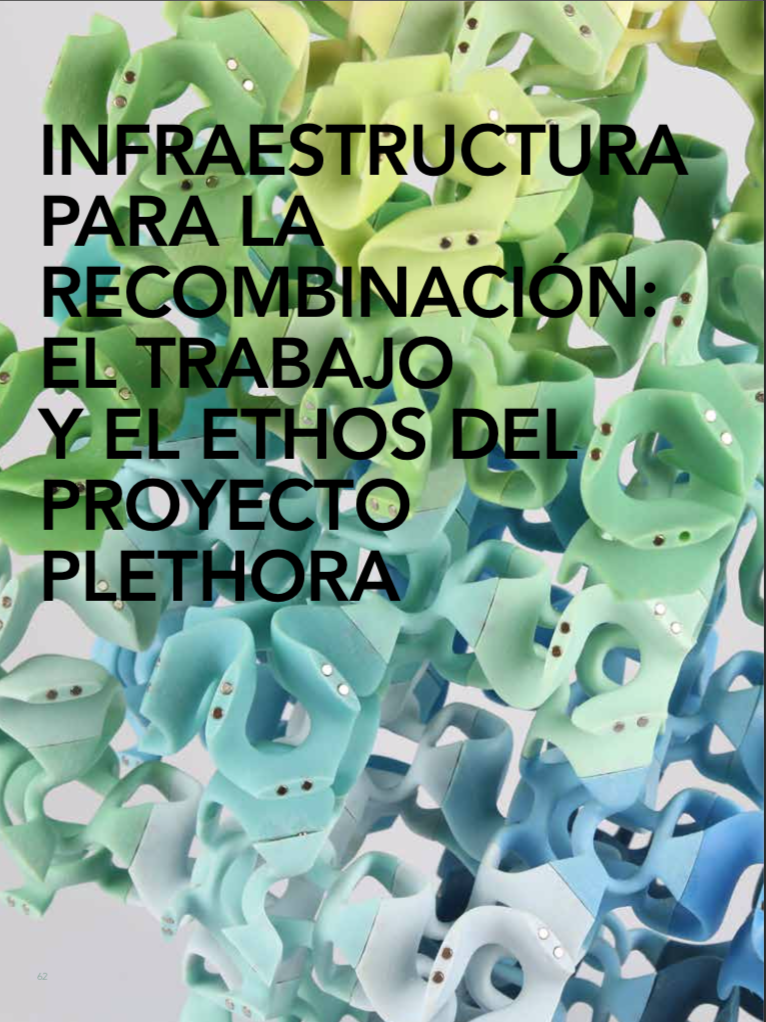Infraestructura para la recombinación: el trabajo y el ethos del proyecto Plethora
Contenido principal del artículo
Resumen
Este trabajo presenta una critica al modelo de negocios tradicional usado por muchas oficinas de arquitectura que utilizan el “concurso de arquitectura” como una manera de desarrollar nuevas ideas e innovar. Los nume- rosos concursos de arquitectura, que implican trabajo no remunerado, se han convertido en un mecanismo para forzar la innovacion arquitectonica en beneficio de la elite dominante. El taller Proyecto Plethora ha tra- tado, desde 2011, de hibridar la practica de la arquitectura con formas de entretenimiento que permitan el compromiso cultural y, en ultima instancia, comunicar los desafis que enfrenta la arquitectura no solo desde una perspectiva de progreso tecnologico sino tambien desde un plano de progreso social. Para hacer esto, el medio de los videojuegos ha sido elegido por su capacidad de comunicar complejos sistemas de interde- pendencia, invitando a un publico nuevo, sin conocimientos de arquitectura, a participar en la construccion de conocimiento y de nuevos discursos por medio de la comprension de redes complejas de interdependencia que unen recursos materiales, conocimiento, trabajo y acceso. El taller se posiciona en la interseccion entre la oficina de arquitectura y un estudio de videojuegos con interes social. Esto implica la necesidad de innovacion en estrategias economicas que permitan la autonomi de ideas y el desarrollo de proyectos no convencionales.
Abstract_
This paper presents a critique to the traditional business model followed by many architecture studios who utilize the ‘architectural competition’ as a format for developing new ideas and innovation. The abundant competition calls, implying free labour, that architectural competitions facilitate has become a mechanism to coerce architectural innovation towards the benefit of a ruling elite. The Plethora Project studio has attempted since 2011 to hybridize the practice of architecture with forms of entertainment in order to allow cultural engagement and ultimately communicate the challenges that architecture faces not only from a perspective of technological progress but from one of social progress as well. To do so, the medium of video games has been selected to communicate complex systems of interdependence, inviting a new audience of non-architects to participate in the construction of knowledge and discourse by understanding complex webs of interdependence that link material resources, knowledge, labour and access. The studio sits at the intersection between an architectural firm and a gaming studio with social interest. This implies the necessity for innovation in economic strategies that enable the autonomy of ideas and the development of non-conventional projects.
Detalles del artículo

Esta obra está bajo una licencia internacional Creative Commons Atribución-NoComercial 4.0.
Materia Arquitectura proporciona acceso inmediato y gratuito a todos los contenidos de esta edición electrónica, publicada simultáneamente con la edición impresa. Materia Arquitectura no cobra honorarios a los autores por ningún concepto.
Todos los contenidos de esta edición electrónica se distribuyen bajo licencia Creative Commons de “Atribución-Copartirigual 4.0 Internacional” (CC-BY-SA).
La licencia Creative Commons permite el acceso libre e inmediato al contenido y permite que cualquier usuario lea, descargue, copie, distribuya, imprima, busque o genere enlaces a los textos completos de los artículos, permitiendo también que estos puedan ser rastreados para indexarlos, pasarlos como datos a software o usarlos para cualquier otro propósito legal. Asimismo, la licencia otorga derechos de uso a quienes a su vez utilicen una licencia abierta (Creative Commons o equivalente).
Los derechos de los textos y las imágenes publicadas pertenecen a sus autores, quienes otorgan a Materia Arquitectura la licencia para su uso. La gestión de los permisos y la autorización de publicación de las imágenes (o de cualquier material) que contenga derechos de autor y sus consecuentes derechos de reproducción en esta publicación es de exclusiva responsabilidad de los autores de los artículos.
Toda vez que mencionen su origen, los autores son libres de distribuir sus artículos por otros medios. Cualquier reproducción total o parcial del material deberá citar su procedencia.
Descargas
Citas
BOGOST, I. (2006). Unit Operations: An Approach to Videogame Criticism. Cambridge, MA: MIT.
BRAYER, M.-A., & MIGAYROU, F. (2013). Naturalizing Architecture: Archilab 2013. Orleans, Francia: Editions HYX.
COOPER, S., TREUILLE, A., BARBERO, J., LEAVER-FAY, A., TUITE, K., KHATIB, F., ... POPOVIC, Z. (2010). The Challenge of Designing Scientific Discovery Games. En Proceedings of the Fifth International Conference on the Foundations of Digital Games (pp. 40–47). ACM.
GERSHENFELD, N. A., & WARD, J. D. (2016). US9506485B2. United States. Recuperado de https://patents.google.com/patent/US9506485B2/en
LICKLIDER, J. C. R. (1960). Man-Computer Symbiosis. IRE Transactions on Human Factors in Electronics, HFE-1(1), 4–11. Doi: 10.1109/THFE2.1960.4503259
MAAS, W., GRAAFLAND, A., BATSTRA, B., VAN BILSEN, A., & PINILLA, C. (Eds.). (2007). Spacefighter: The Evolutionary City (Game:). Barcelona, España: Actar.
SÁNCHEZ, J., & ANDRASEK, A. (2017). BLOOM. En F. Gramazio, M. Kohler, & S. Langenberg (Eds.), Fabricate 2014 (pp. 98–103). Londres, Inglaterra: UCL Press.
SCHOLZ, T., & SCHNEIDER, N. (2017). Ours to Hack and to Own: The Rise of Platform Cooperativism, a New Vision for the Future of Work and a Fairer Internet. Nueva York, NY: OR Books.
SCHUMACHER, P. (2011). The Autopoiesis of Architecture: A New Framework for Architecture. Chichester, Inglaterra: Wiley.
SRNICEK, N. (2016). Platform Capitalism. Cambridge, Inglaterra: Polity Press.
